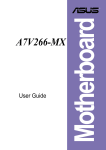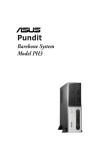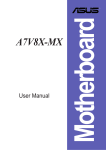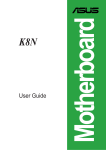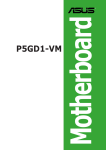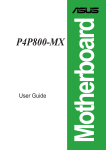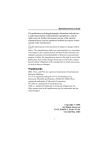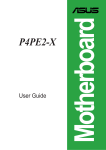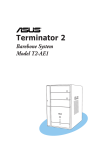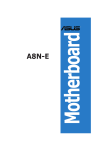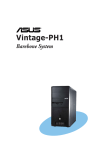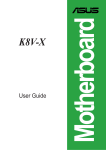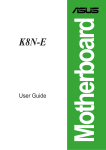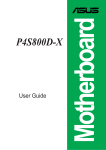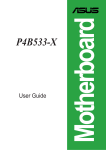Download Asus P4U800-X User guide
Transcript
User Guide Motherboard P4U800-X E1882 Checklist Revised Edition V3 January 2005 Copyright © 2005 ASUSTeK COMPUTER INC. All Rights Reserved. No part of this manual, including the products and software described in it, may be reproduced, transmitted, transcribed, stored in a retrieval system, or translated into any language in any form or by any means, except documentation kept by the purchaser for backup purposes, without the express written permission of ASUSTeK COMPUTER INC. (“ASUS”). Product warranty or service will not be extended if: (1) the product is repaired, modified or altered, unless such repair, modification of alteration is authorized in writing by ASUS; or (2) the serial number of the product is defaced or missing. ASUS PROVIDES THIS MANUAL “AS IS” WITHOUT WARRANTY OF ANY KIND, EITHER EXPRESS OR IMPLIED, INCLUDING BUT NOT LIMITED TO THE IMPLIED WARRANTIES OR CONDITIONS OF MERCHANTABILITY OR FITNESS FOR A PARTICULAR PURPOSE. IN NO EVENT SHALL ASUS, ITS DIRECTORS, OFFICERS, EMPLOYEES OR AGENTS BE LIABLE FOR ANY INDIRECT, SPECIAL, INCIDENTAL, OR CONSEQUENTIAL DAMAGES (INCLUDING DAMAGES FOR LOSS OF PROFITS, LOSS OF BUSINESS, LOSS OF USE OR DATA, INTERRUPTION OF BUSINESS AND THE LIKE), EVEN IF ASUS HAS BEEN ADVISED OF THE POSSIBILITY OF SUCH DAMAGES ARISING FROM ANY DEFECT OR ERROR IN THIS MANUAL OR PRODUCT. SPECIFICATIONS AND INFORMATION CONTAINED IN THIS MANUAL ARE FURNISHED FOR INFORMATIONAL USE ONLY, AND ARE SUBJECT TO CHANGE AT ANY TIME WITHOUT NOTICE, AND SHOULD NOT BE CONSTRUED AS A COMMITMENT BY ASUS. ASUS ASSUMES NO RESPONSIBILITY OR LIABILITY FOR ANY ERRORS OR INACCURACIES THAT MAY APPEAR IN THIS MANUAL, INCLUDING THE PRODUCTS AND SOFTWARE DESCRIBED IN IT. Products and corporate names appearing in this manual may or may not be registered trademarks or copyrights of their respective companies, and are used only for identification or explanation and to the owners’ benefit, without intent to infringe. ii Contents Features Notices ............................................................................................ v Safety information .......................................................................... vi About this guide ............................................................................. vii Conventions used in this guide ............................................ vii Where to find more information ............................................ vii P4U800-X specification summary ................................................ viii Chapter 1: Product introduction 1.1 Welcome! ........................................................................... 1-2 1.2 Package contents ............................................................... 1-2 1.3 Special features .................................................................. 1-2 1.4 Before you proceed ............................................................ 1-4 1.5 Motherboard overview ........................................................ 1-5 1.5.1 Motherboard layout ................................................ 1-5 1.5.2 Placement direction ............................................... 1-6 1.5.3 Screw holes ........................................................... 1-6 Central Processing Unit (CPU) ........................................... 1-7 1.6.1 Overview ................................................................ 1-7 1.6.2 Installing the CPU .................................................. 1-8 System memory ................................................................. 1-9 1.7.1 DIMM sockets location ........................................... 1-9 1.7.2 Memory configurations .......................................... 1-9 1.7.3 Installing a DIMM ................................................. 1-10 Expansion slots ................................................................. 1-11 1.8.1 Standard interrupt assignments ............................1-11 1.8.2 IRQ assignments for this motherboard ................. 1-11 1.8.3 PCI slots .............................................................. 1-12 1.8.4 AGP slot ............................................................... 1-12 Jumpers ............................................................................ 1-13 1.6 1.7 1.8 1.9 1.10 Connectors ....................................................................... 1-15 1.10.1 Rear panel connectors ......................................... 1-15 1.10.2 Internal connectors .............................................. 1-16 iii Contents Safeguards Chapter 2: BIOS Information 2.1 2.2 2.3 Managing and updating your BIOS .................................... 2-2 2.1.1 Creating a bootable floppy disk ............................. 2-2 2.1.2 Updating the BIOS with EZ Flash feature .............. 2-3 2.1.3 Recovering the BIOS with CrashFree BIOS .......... 2-4 2.1.4 ASUS Update ........................................................ 2-5 BIOS Setup program .......................................................... 2-7 2.2.1 BIOS menu screen ................................................ 2-8 2.2.2 Menu bar ................................................................ 2-8 2.2.3 Legend bar ............................................................. 2-9 2.2.4 General help .......................................................... 2-9 2.2.5 Sub-menu .............................................................. 2-9 2.2.6 Pop-up window ...................................................... 2-9 Main menu ........................................................................ 2-10 Primary and Secondary Master/Slave .............................. 2-12 2.4 2.6 Advanced menu ............................................................... 2-15 2.4.1 Frequency/Voltage Control .................................. 2-16 2.4.2 Chip Configuration ............................................... 2-17 2.4.3 I/O Device Configuration ...................................... 2-19 2.4.4 PCI Configuration ................................................ 2-20 Power menu ..................................................................... 2-22 2.5.1 Power Up Control ................................................ 2-23 2.5.2 Hardware Monitor ................................................ 2-25 Boot menu ........................................................................ 2-26 2.7 Exit menu ......................................................................... 2-28 2.5 Chapter 3: Software support iv 3.1 Install an operating system ................................................. 3-2 3.2 Support CD information ...................................................... 3-2 3.2.1 Running the support CD ........................................ 3-2 3.2.2 Drivers menu ......................................................... 3-3 3.2.3 Utilities menu ......................................................... 3-3 3.2.4 ASUS Contact Information ..................................... 3-4 Notices Federal Communications Commission Statement This device complies with Part 15 of the FCC Rules. Operation is subject to the following two conditions: • This device may not cause harmful interference, and • This device must accept any interference received including interference that may cause undesired operation. This equipment has been tested and found to comply with the limits for a Class B digital device, pursuant to Part 15 of the FCC Rules. These limits are designed to provide reasonable protection against harmful interference in a residential installation. This equipment generates, uses and can radiate radio frequency energy and, if not installed and used in accordance with manufacturer’s instructions, may cause harmful interference to radio communications. However, there is no guarantee that interference will not occur in a particular installation. If this equipment does cause harmful interference to radio or television reception, which can be determined by turning the equipment off and on, the user is encouraged to try to correct the interference by one or more of the following measures: • Reorient or relocate the receiving antenna. • Increase the separation between the equipment and receiver. • Connect the equipment to an outlet on a circuit different from that to which the receiver is connected. • Consult the dealer or an experienced radio/TV technician for help. The use of shielded cables for connection of the monitor to the graphics card is required to assure compliance with FCC regulations. Changes or modifications to this unit not expressly approved by the party responsible for compliance could void the user’s authority to operate this equipment. Canadian Department of Communications Statement This digital apparatus does not exceed the Class B limits for radio noise emissions from digital apparatus set out in the Radio Interference Regulations of the Canadian Department of Communications. This class B digital apparatus complies with Canadian ICES-003. v Safety information Electrical safety • To prevent electrical shock hazard, disconnect the power cable from the electrical outlet before relocating the system. • When adding or removing devices to or from the system, ensure that the power cables for the devices are unplugged before the signal cables are connected. If possible, disconnect all power cables from the existing system before you add a device. • Before connecting or removing signal cables from the motherboard, ensure that all power cables are unplugged. • Seek professional assistance before using an adpater or extension cord. These devices could interrupt the grounding circuit. • Make sure that your power supply is set to the correct voltage in your area. If you are not sure about the voltage of the electrical outlet you are using, contact your local power company. • If the power supply is broken, do not try to fix it by yourself. Contact a qualified service technician or your retailer. Operation safety • Before installing the motherboard and adding devices on it, carefully read all the manuals that came with the package. • Before using the product, make sure all cables are correctly connected and the power cables are not damaged. If you detect any damage, contact your dealer immediately. • To avoid short circuits, keep paper clips, screws, and staples away from connectors, slots, sockets and circuitry. • Avoid dust, humidity, and temperature extremes. Do not place the product in any area where it may become wet. • Place the product on a stable surface. • If you encounter technical problems with the product, contact a qualified service technician or your retailer. vi About this guide Conventions used in this guide To make sure that you perform certain tasks properly, take note of the following symbols used throughout this manual. WARNING: Information to prevent injury to yourself when trying to complete a task. CAUTION: Information to prevent damage to the components when trying to complete a task. IMPORTANT: Information that you MUST follow to complete a task. NOTE: Tips and additional information to aid in completing a task. Where to find more information Refer to the following sources for additional information and for product and software updates. 1. ASUS Websites The ASUS websites worldwide provide updated information on ASUS hardware and software products. The ASUS websites are listed in the ASUS Contact Information on the inside front cover. 2. Optional Documentation Your product package may include optional documentation, such as warranty flyers, that may have been added by your dealer. These documents are not part of the standard package. vii P4U800-X specification summary CPU Socket 478 for Intel® Pentium® 4 / Celeron with speeds up to 3.4GHz Supports Intel® Hyper-Threading technology New power design supports next generation Intel Prescott CPU Chipset ULI M1683 ULI M1563 Front Side Bus (FSB) 800/533/400 MHz Memory 3 x 184-pin DDR DIMM sockets for up to 3GB memory Supports PC3200/PC2700/PC2100 unbuffered non-ECC DDR DIMMs Expansion slots 1 x AGP 8X/4X 5 x PCI Storage 2 x UltraDMA 133/100/66/33 connectors Audio ADI AD1888 SoundMAX 6-channel audio CODEC support S/PDIF out interface LAN ULI M1563 integrated 10/100 Mbps MAC with VIA VT6103 PHY Special features ASUS EZ Flash ASUS C.P.R. (CPU Parameter Recall) ASUS CrashFree BIOS Overclocking ASUS JumperFree SFS (Stepless Frequency Selection) at 1Mhz increment Adjustable FSB/DDR ratio ASUS C.P.R. (CPU Parameter Recall) Rear panel I/O 1 x Parallel port 1 x Serial port 1 x PS/2 keyboard port 1 x PS/2 mouse port 4 x USB 2.0 ports 1 x RJ-45 port Line In/Line Out/Microphone ports 1 x S/PDIF out port (continued on the next page) viii P4U800-X specification summary Internal I/O 1 x USB 2.0 connector for 2 additional USB ports CPU/Chassis fan connectors 20-pin/4-pin ATX 12V power connectors CD/AUX/MODEM connectors Game/MIDI port connector 20-pin panel connector Front panel audio connector BIOS features 2Mb Flash ROM, AMI BIOS, ACPI, PnP, DMI2.0, WfM 2.0, SM BIOS 2.3, DMI 2.0, ASUS CrashFree BIOS, ASUS EZ Flash Industry standard PCI 2.2, USB 2.0/1.1 Manageability DMI 2.0, WOL/WOR by PME, SMBus Power Requirement ATX power supply (with 4-pin 12V plug) Form Factor ATX form factor: 12 in x 8.6 in (30.5 cm x 20.8 cm) Support CD contents Device drivers ASUS PC Probe ASUS LiveUpdate Anti-virus utility * Specifications are subject to change without notice. ix x Chapter 1 This chapter describes the features of the P4U800-X motherboard. It includes brief descriptions of the motherboard components, and illustrations of the layout, jumper settings, and connectors. Product introduction 1.1 Welcome! Thank you for buying the ASUS® P4U800-X motherboard! The ASUS P4U800-X motherboard, based on the ULI® M1683 chipset supporting 800 FSB that delivers a host of new features and latest technologies making it another standout in the long line of ASUS quality motherboards! Before you start installing the motherboard, and hardware devices on it, check the items in your package with the list below. 1.2 Package contents Check your P4U800-X package for the following items. ASUS P4U800-X motherboard ASUS motherboard support CD 1 x UltraDMA 100/66 cable 1 x Floppy disk cable I/O shield Bag of extra jumper caps User Guide If any of the above items is damaged or missing, contact your retailer. 1.3 Special features Latest processor technology The motherboard supports the latest Intel® Pentium® 4 Processor via a 478-pin surface mount ZIF socket. The Pentium 4 processor with 512KB L2 cache on 0.13 micron processor includes a 800/533/400 MHz system bus, Intel® Hyper-Threading Technology and the FMB2 power design that allows up to 3.2+ GHz core frequencies for up to 6.4GB/s data transfer rates. See page 1-7. DDR400 (PC3200) support DDR400 (PC3200), the latest and fastest DDR memory standard, supports bandwidth of up to 3.2 GB/s to provide enhanced system performance. See 1-9. 1-2 Chapter 1: Product introduction CrashFree BIOS This feature allows you to restore the original BIOS data from a floppy disk in case the BIOS codes and data are corrupted. This protection eliminates the need to buy a replacement ROM chip. AGP 8X support AGP 8X (AGP 3.0) is the next generation VGA interface specification that enables enhanced graphics performance with high bandwidth speeds up to 2.12 GB/s. With a bus of 533Mhz, AGP 8X is twice as fast as AGP 4X. USB 2.0 technology The motherboard implements the new Universal Serial Bus (USB) 2.0 specification, extending the connection speed from 12 Mbps on USB 1.1 to a fast 480 Mbps on USB 2.0. See page 1-15. 10/100 Mbps LAN support Easy connectivity to your network or broadband connection with the onboard LAN port. See page 3-3. 6-channel digital audio The ADI AD1888 AC’97 audio CODEC onboard provides 6-channel audio playback for 5.1 surround sound using digital audio devices via a Sony/Philips Digital Interface (S/PDIF) jack located at the rear panel I/O. See page 3-3. ASUS P4U800-X motherboard 1-3 1.4 Before you proceed Take note of the following precautions before you install motherboard components or change any motherboard settings. 1. 2. 3. 4. 5. Unplug the power cord from the wall socket before touching any component. Use a grounded wrist strap or touch a safely grounded object or to a metal object, such as the power supply case, before handling components to avoid damaging them due to static electricity. Hold components by the edges to avoid touching the ICs on them. Whenever you uninstall any component, place it on a grounded antistatic pad or in the bag that came with the component. Before you install or remove any component, ensure that the ATX power supply is switched off or the power cord is detached from the power supply. Failure to do so may cause severe damage to the motherboard, peripherals, and/or components. Onboard LED The motherboard comes with a stand-by power LED. When lit, the green LED indicates that the system is ON, in sleep mode, or in soft-off mode, a reminder that you should shut down the system and unplug the power cable before removing or plugging in any motherboard component. The illustration below shows the location of the onboard LED. P4U800-X SB_PWR ® P4U800-X Onboard LED 1-4 ON Standby Power OFF Powered Off Chapter 1: Product introduction 1.5 Motherboard overview 1.5.1 Motherboard layout PS/2KBMS T: Mouse B: Keyboard CPU_FAN1 USB12 ULi M1683 ATX12V1 USB2.0 Top: T: USB3 RJ-45 B: USB4 Top:Line In Center:Line Out Below:Mic In ATXPWR1 DDR DIMM3 (64 bit,184-pin module) USBPW34 USBPW12 COM1 DDR DIMM2 (64 bit,184-pin module) SPDIF_O DDR DIMM1 (64 bit,184-pin module) PARALLEL PORT Socket 478 P4U800-X Accelerated Graphics Port (AGP1) PCI1 2Mbit Firmware Hub ULi M1563 PCI2 CLRTC PCI3 Super I/O PCI4 ® AD1888 AUX CHASSIS1 FLOPPY1 SB_PWR CR2032 3V Lithium Cell CMOS Power PRI_IDE1 SEC_IDE1 PCI5 CD USBPW56 FP_AUDIO GAME1 ASUS P4U800-X motherboard CHA_FAN1 USB56 PANEL 1-5 1.5.2 Placement direction When installing the motherboard, make sure that you place it into the chassis in the correct orientation. The edge with external ports goes to the rear part of the chassis as indicated in the image below. 1.5.3 Screw holes Place seven (7) screws into the holes indicated by circles to secure the motherboard to the chassis. Do not overtighten the screws! Doing so may damage the motherboard. Place this side towards the rear of the chassis 1-6 Chapter 1: Product introduction 1.6 Central Processing Unit (CPU) 1.6.1 Overview The Intel® Pentium® 4 processors has a gold triangular mark on one corner. This mark indicates the processor Pin 1 that should match a specific corner of the CPU socket. Gold Arrow P4U800-X ® P4U800-X Socket 478 Incorrect installation of the CPU into the socket may bend the pins and severely damage the CPU! Notes on Intel® Hyper-Threading Technology 1. 2. 3. 4. 5. 6. This motherboard supports Intel® Pentium® 4 CPUs with Hyper-Threading Technology. Make sure to enable the Hyper-Threading Technology item in the BIOS before installing a supported operating system. To verify the Hyper-Threading feature, go to the Windows OS System Properties -> Hardware -> Device Manager -> Processors. The list should display two existing processors. Hyper-Threading Technology is supported under Windows® XP™ and later versions only. It is recommended that you install Windows® XP™ Service Pack 1. For more information on Hyper-Threading Technology, visit www.intel.com/info/hyperthreading. To use the Hyper-Threading Technology on this motherboard: 1. Buy an Intel® Pentium® 4 CPU that supports Hyper-Threading Technology. Install the CPU. 2. Power up the system and enter the BIOS setup (See Chapter 2: BIOS Information). Under the Advanced Menu, make sure that the item Hyper-Threading Technology is set to Enabled. The item appears only if you installed a CPU that supports Hyper-Threading Technology. 3. Reboot the computer. ASUS P4U800-X motherboard 1-7 1.6.2 Installing the CPU Follow these steps to install a CPU. 1. Locate the 478-pin ZIF socket on the motherboard. 2. Unlock the socket by pressing the lever sideways, then lift it up to a 90°100° angle. Socket Lever 90 - 100 Make sure that the socket lever is lifted up to 90°-100° angle, otherwise the CPU does not fit in completely. 3. Position the CPU above the socket such that its marked corner matches the base of the socket lever. Gold Mark 4. Carefully insert the CPU into the socket until it fits in place. The CPU fits only in one correct orientation. DO NOT force the CPU into the socket to prevent bending the pins and damaging the CPU! 5. When the CPU is in place, push down the socket lever to secure the CPU. The lever clicks on the side tab to indicate that it is locked. 6. Install a CPU heatsink and fan following the instructions that came with the heatsink package. 7. Connect the CPU fan cable to the CPU fan connector on the motherboard. 1-8 Chapter 1: Product introduction 1.7 System memory 1.7.1 DIMM sockets location 104 Pins The following figure illustrates the location of the DDR DIMM sockets. DIMM3 P4U800-X 184-Pin DDR DIMM Sockets DIMM2 ® DIMM1 80 Pins P4U800-X 1. Make sure to unplug the power supply before adding or removing DIMMs or other system components. Failure to do so may cause severe damage to both the motherboard and the components. 2. When installing long AGP cards, it is recommended to install the memory modules first. Long AGP cards, when installed, may interfere with the memory sockets. 1.7.2 Memory configurations You may install 64MB, 128MB, 256MB, 512MB, and 1GB DDR DIMMs into the DIMM sockets using the memory configurations in this section. Important notes 1. 2. 3. For optimum compatibility, it is recommended that you obtain memory modules from the same vendor. See the DDR400 Qualified Vendor List (QVL) on page 1-10. Always install DIMMs with the same CAS Latency. Double-sided DDR DIMMs with x16 (data bus=16bit) memory chips are not supported due to chipset limitation. ASUS P4U800-X motherboard 1-9 Table 1 DDR400 Qualified Vendor List (QVL) Size Vendor 256MB 512MB 256MB 512MB 256MB 512MB 512MB 256MB 512MB 256MB 256MB 512MB 256MB 512MB 256MB 512MB 256MB 256MB 512MB 512MB KINGSTON KINGSTON KINGSTON KINGSTON KINGSTON KINGSTON KINGSTON SAMSUNG SAMSUNG SAMSUNG Hynix Hynix MICRON MICRON Infineon Infineon Infineon CORSAIR CORSAIR CORSAIR Model KVR400X64C3A/256 KVR400X64C3A/512 KVR400X64C3A/256 KVR400X64C3A/512 KVR400X64C3A/256 KVR400X64C3A/512 KHX3200A/512 M368L3223ETM-CCC M368L6423ETM-CCC M368L3223FTN-CCC HYMD232646B8J-D43 AA HYMD264646B8J-D43 AA MT8VDDT3264AG-40BCB MT16VDDT6464AG-40BCB HYS64D32300GU-5-B HYS64D64320GU-5-B HYS64D32300HU-5-C CMX256A-3200C2PT CMX512-3200C2 VS512MB400 Side(s): SS - Single Sided CL Brand Side(s) N/A N/A N/A N/A N/A N/A N/A N/A 3 3 3 N/A N/A N/A 3 3 3 2 2 2.5 Hynix Hynix Infineon Infineon KINGSTON KINGSTON N/A SAMSUNG SAMSUNG SAMSUNG Hynix Hynix MICRON MICRON Infineon Infineon Infineon Winbond Winbond VALUE seLecT SS DS SS DS SS DS DS SS DS SS SS DS SS DS SS DS SS SS DS DS Component DIMM support A* B* HY5DU56822BT-D43 HY5DU56822BT-D43 HYB25D256800BT-5B HYB25D256809BT-5B D3208DL2T-5 D328DIB-50 Heat-Sink Package K4H560838E-TCCC K4H560838E-TCCC K4H560838F-TCCC HY5DU56822BT-D43 HY5DU56822BT-D43 MT46V32M8TG-5BC MT46V32M8TG-5BC HYB25D256800BT-5B HYB25D256800BT-5B HYB25D256800CE-5C W942508BH-5 Heat-Sink Package VS32M8-5 • • • • • • • • • • • • • • • • • • • • • • • • • • • • • • • • • DS - Double Sided CL - CAS Latency DIMM Support: A - supports one module inserted into either slot, in a Single-channel memory configuration. B - supports on pair of modules inserted into two slots as a Single-channel memory configuration. • • Use of three DDR400 DIMM modules on all slots is not recommended. The operating memory frequency will work only at 266MHz when you install DDR400 DIMM modules to all slots. Obtain DDR 400 DIMMs only from ASUS qualified vendors. Visit the ASUS website (www.asus.com) for the latest QVL. 1.7.3 Installing a DIMM DDR DIMM Follow these steps to install a DIMM. 1. Unlock a DIMM socket by pressing the retaining clips outward. 2. Align a DIMM on the socket such that the notch on the DIMM matches the break on the socket. 3. Firmly insert the DIMM into the socket until the retaining clips snap back in place and the DIMM is properly seated. Unlocked A DDR DIMM is keyed with a notch so that it fits in only one direction. DO NOT force a DIMM into a socket to avoid damaging the DIMM. 1-10 Chapter 1: Product introduction 1.8 Expansion slots To install and configure an expansion card: 1. Install an expansion card following the instructions that came with the chassis. 2. Turn on the system and change the necessary BIOS settings, if any. See Chapter 2 for BIOS information. 3. Assign an IRQ to the card. Refer to the tables next page. 4. Install the drivers and/or software applications for the expansion card according to the card documentation. 1.8.1 Standard interrupt assignments IRQ 0 1 2 3* 4* 5* 6 7* 8 9* 10* 11* 12* 13 14* 15* * Priority 1 2 N/A 11 12 13 14 15 3 4 5 6 7 8 9 10 Standard Function System Timer Keyboard Controller Programmable Interrupt IRQ holder for PCI steering Communications Port (COM1) IRQ holder for PCI steering Floppy Disk Controller Printer Port (LPT1) System CMOS/Real Time Clock IRQ holder for PCI steering IRQ holder for PCI steering IRQ holder for PCI steering PS/2 Compatible Mouse Port Numeric Data Processor Primary IDE Channel Secondary IDE Channel These IRQs are usually available for ISA or PCI devices. 1.8.2 IRQ assignments for this motherboard PCI slot 1 PCI slot 2 PCI slot 3 PCI slot 4 PCI slot 5 AGP slot Onboard USB controller 0 Onboard USB controller 1 Onboard USB controller 2 Onboard LAN Onboard Audio A — — — — — used — — — — — B shared — — — — — — — — — — C D E F — — — — shared — — — — shared — — — — shared — — — — shared — — — — shared — — — shared — — — shared — — — — shared — — — — — shared G — — — — — — — — — — — H — — — — — — — — — — — When using PCI cards on shared slots, ensure that the drivers support “Share IRQ” or that the cards do not need IRQ assignments. Otherwise, conflicts will arise between the two PCI groups, making the system unstable and the card inoperable. ASUS P4U800-X motherboard 1-11 1.8.3 PCI slots The PCI slots support PCI cards such as a LAN card, SCSI card, USB card, and other cards that comply with PCI specifications. 1.8.4 AGP slot The Accelerated Graphics Port (AGP) slot that supports AGP 8X/4X (+1.5V) cards. When you buy an AGP card, make sure that you ask for one with +1.5V specification. Note the notches on the card golden fingers to ensure that they fit the AGP slot on the motherboard. Install only +1.5V AGP cards. P4U800-X ® Keyed for 1.5v P4U800-X Accelerated Graphics Port (AGP) If installing the ATI 9500 or 9700 Pro Series VGA cards, use only the card version PN xxx-xxxxx-30 or later, for optimum performance and overclocking stability. 1-12 Chapter 1: Product introduction 1.9 Jumpers 1. Clear RTC RAM (CLRTC1) This jumper allows you to clear the Real Time Clock (RTC) RAM in CMOS. You can clear the CMOS memory of date, time, and system setup parameters by erasing the CMOS RTC RAM data. The RAM data in CMOS, that include system setup information such as system passwords, is powered by the onboard button cell battery. To erase the RTC RAM: 1. Turn OFF the computer and unplug the power cord. 2. Move the jumper cap from pins 1-2 (default) to pins 2-3. Keep the cap on pins 2-3 for about 5~10 seconds, then move the cap back to pins 1-2. 3. Plug the power cord and turn ON the computer. 4. Hold down the <Del> key during the boot process and enter BIOS setup to re-enter data. Except when clearing the RTC RAM, never remove the cap on CLRTC1 jumper default position. Removing the cap will cause system boot failure! P4U800-X ® CLRTC 2 1 Normal (Default) 3 2 Clear CMOS P4U800-X Clear RTC RAM You do not need to clear the RTC when the system hangs due to overclocking. For system failure due to overclocking, use the C.P.R. (CPU Parameter Recall) feature. Shut down and reboot the system so BIOS can automatically reset parameter settings to default values. ASUS P4U800-X motherboard 1-13 2. USB device wake-up (3-pin USBPW12, USBPW34, USBPW56) Set these jumpers to +5V to wake up the computer from S1 sleep mode (CPU stopped, DRAM refreshed, system running in low power mode) using the connected USB devices. Set to +5VSB to wake up from S3 sleep mode (no power to CPU, DRAM in slow refresh, power supply in reduced power mode). Both jumpers are set to pins 1-2 (+5V) by default because not all computers have the appropriate power supply to support this feature. The USBPW12 and USBPW34 jumpers are for the rear USB ports. The USBPW56 jumper is for the internal USB header that you can connect to the front USB ports. 1. 2. 3. This feature requires a power supply that can provide at least 1A on the +5VSB lead when these jumpers are set to +5VSB. Otherwise, the system would not power up. The total current consumed must NOT exceed the power supply capability (+5VSB) whether under normal condition or in sleep mode. The rear panel USB ports (Ports 1 to 4) do not support device wake-up from S4 sleep mode. USBPW12 USBPW34 3 2 2 1 P4U800-X +5V (Default) +5VSB USBPW56 ® P4U800-X USB device wake up 1-14 2 3 1 2 +5V (Default) +5VSB Chapter 1: Product introduction 1.10 Connectors This section describes and illustrates the motherboard rear panel and internal connectors. 1.10.1 Rear panel connectors 1 2 3 4 5 6 10 11 9 8 7 1. PS/2 mouse port. This green 6-pin connector is for a PS/2 mouse. 2. Parallel port. This 25-pin port connects a parallel printer, a scanner, or other devices. 3. RJ-45 port. This port allows connection to a Local Area Network (LAN) through a network hub. 4. Line In jack. This Line In (light blue) jack connects a tape player or other audio sources. In 6-channel mode, the function of this jack becomes Bass/Center. 5. Line Out jack. This Line Out (green) jack connects a headphone or a speaker. In 6-channel mode, the function of this jack becomes Front Speaker Out. 6. Microphone jack. This Mic (pink) jack connects a microphone. In 6-channel mode, the function of this jack becomes Rear Speaker Out. The functions of the Line Out, Line In, and Microphone jacks change when you select the 6-channel audio configuration as shown in the following table. Audio 2, 4 or 6-channel configuration Light Blue Green Pink Headphone/ 2-Speaker Line In Line Out Mic In 4-Speaker Line In Front Speaker Out Rear Speaker Out 6-Speaker Bass/Center Front Speaker Out Rear Speaker Out 7. USB 2.0 ports 1 and 2. These two 4-pin Universal Serial Bus (USB) ports are available for connecting USB 2.0 devices. 8. USB 2.0 ports 3 and 4. These two 4-pin Universal Serial Bus (USB) ports are available for connecting USB 2.0 devices. 9. Serial connector. This 9-pin COM1 port is for serial devices. 10. S/PDIF out jack. This jack connects to external audio output devices. 11. PS/2 keyboard port. This purple connector is for a PS/2 keyboard. ASUS P4U800-X motherboard 1-15 1.10.2 Internal connectors 1. IDE connectors (40-1 pin PRI_IDE1, SEC_IDE1) This connector supports the provided UltraATA133 IDE hard disk ribbon cable. Connect the cable’s blue connector to the primary (recommended) or secondary IDE connector, then connect the gray connector to the UltraATA133 slave device (hard disk drive) and the black connector to the UltraATA133 master device. 1. Follow the hard disk drive documentation when setting the device in master or slave mode. 2. Pin 20 on each IDE connector is removed to match the covered hole on the UltraATA cable connector. This prevents incorrect orientation when you connect the cables. 3. The hole near the blue connector on the UltraATA cable is intentional. PIN 1 P4U800-X IDE connectors PRI_IDE1 ® SEC_IDE1 P4U800-X NOTE: Orient the red markings (usually zigzag) on the IDE ribbon cable to PIN 1. 2. Floppy disk drive connector (34-1 pin FLOPPY1) This connector supports the provided floppy drive ribbon cable. After connecting one end to the motherboard, connect the other end to the floppy drive. (Pin 5 is removed to prevent incorrect insertion when using ribbon cables with pin 5 plug). P4U800-X FLOPPY1 PIN 1 ® NOTE: Orient the red markings on the floppy ribbon cable to PIN 1. P4U800-X Floppy disk drive connector 1-16 Chapter 1: Product introduction 3. ATX power connectors (20-pin ATXPWR1, 4-pin ATX12V1) These connectors connect to an ATX 12V power supply. The plugs from the power supply are designed to fit these connectors in only one orientation. Find the proper orientation and push down firmly until the connectors completely fit. In addition to the 20-pin ATX power connector, this motherboard requires that you connect the 4-pin ATX +12V power plug to provide sufficient power to the CPU. Make sure that your ATX 12V power supply can provide 10A on the +12V lead and at least 2A on the +5-volt standby lead (+5VSB). The minimum recommended wattage is 250W, or 300W for a fully configured system. The system may become unstable and may experience difficulty powering up if the power supply is inadequate. ATXPWR1 ATX12V Pin 1 +12.0VDC +5VSB PWR_OK COM +5.0VDC COM +5.0VDC COM +3.3VDC +3.3VDC P4U800-X ® +5.0VDC +5.0VDC -5.0VDC COM COM COM PS_ON# COM -12.0VDC +3.3VDC GND +12V DC GND +12V DC P4U800-X ATX power connectors 4. Internal audio connectors (4-pin CD, AUX) ® AUX (White) Right Audio Channel Ground Ground Left Audio Channel P4U800-X CD (Black) Right Audio Channel Ground Ground Left Audio Channel These connectors allow you to receive stereo audio input from sound sources such as a CD-ROM, TV tuner, or MPEG card. P4U800-X Internal audio connectors ASUS P4U800-X motherboard 1-17 5. CPU, power and chassis fan connectors (3-pin CPU_FAN1, CHA_FAN1) The fan connectors support cooling fans of 350mA~740mA (8.88W max.) or a total of 1A~2.22A (26.64W max.) at +12V. Connect the fan cables to the fan connectors on the motherboard, making sure that the black wire of each cable matches the ground pin of the connector. Do not forget to connect the fan cables to the fan connectors. Lack of sufficient air flow within the system may damage the motherboard components. These are not jumpers! DO NOT place jumper caps on the fan connectors! P4U800-X Rotation +12V GND CPU_FAN1 GND +12V Rotation CHA_FAN1 ® P4U800-X Fan connectors 6. USB header (10-1 pin USB56) If the USB ports on the rear panel are inadequate, a USB header is available for additional USB ports. Connect the USB cable of the USB 2.0 module to this header. You may install the USB module in the chassis front panel. The module has two USB 2.0 ports for connecting next generation USB peripherals such as high resolution cameras, scanners, and printers. USB+5V USB_P8USB_P8+ GND NC P4U800-X USB56 P4U800-X USB 2.0 connector • • 1-18 1 USB+5V USB_P7USB_P7+ GND ® The USB 2.0 module is purchased separately. Install the USB 2.0 driver before using the USB 2.0 feature. Chapter 1: Product introduction 7. Front panel audio connector (10-1 pin FP_AUDIO) This is an interface for the front panel cable that allows convenient connection and control of audio devices. Be default, the pins labeled LINE OUT_R/BLINE_OUT_R and the pins LINE OUT_L/BLINE_OUT_L are shorted with jumper caps. Remove the caps only when you are connecting the front panel audio cable. FP_AUDIO P4U800-X MIC2 MICPWR Line out_R NC Line out_L ® AGND +5VA BLINE_OUT_R BLINE_OUT_L P4U800-X Front panel audio xonnector 8. Chassis intrusion connector (4-1 pin CHASSIS1) This lead is for a chassis designed with intrusion detection feature. This requires an external detection mechanism such as a chassis intrusion sensor or microswitch. When you remove any chassis component, the sensor triggers and sends a high-level signal to this lead to record a chassis intrusion event. P4U800-X ® Chassis Signal GND +5VSB_MB By default, the pins labeled “Chassis Signal” and “Ground” are shorted with a jumper cap. If you wish to use the chassis intrusion detection feature, remove the jumper cap from the pins. CHASSIS1 (Default) P4U800-X intrusion connector ASUS P4U800-X motherboard 1-19 9. GAME/MIDI connector (16-1 pin GAME) This connector supports a GAME/MIDI module. If a GAME/MIDI module is available, connect the GAME/MIDI cable to this connector. The GAME/MIDI port on the module connects a joystick or a game pad for playing games, and MIDI devices for playing or editing audio files. +5V J1B2 J1CY GND GND J1CX J1B1 +5V P4U800-X R P4U800-X Game connector MIDI_IN J2B2 J2CY MIDI_OUT J2CX J2B1 +5V GAME The GAME/MIDI module is purchased separately. 11. System panel connector (10-1 pin PANEL1) This connector accommodates several system front panel functions. Speaker Connector +5V Ground Ground Speaker PLED- PLED+ Power LED ® P4U800-X System panel connector • IDE_LED Reset Ground PWR Ground IDE_LED+ IDE_LED- P4U800-X Reset SW ATX Power Switch* * Requires an ATX power supply. System Power LED Lead (Green 3-1 pin PLED) This 3-1 pin connector connects to the system power LED. The LED lights up when you turn on the system power, and blinks when the system is in sleep mode. • System Warning Speaker Lead (Orange 4-pin SPKR) This 4-pin connector connects to the case-mounted speaker and allows you to hear system beeps and warnings. 1-20 Chapter 1: Product introduction • Reset Switch Lead (Blue 2-pin RESET) This 2-pin connector connects to the case-mounted reset switch for rebooting the system without turning off the system power. • ATX Power Switch/Soft-off Switch Lead (Light Green 2-pin PWR) This connector connects a switch that controls the system power. Pressing the power switch turns the system between ON and SLEEP, or ON and SOFT OFF, depending on the BIOS or OS settings. Pressing the power switch while in the ON mode for more than 4 seconds turns the system OFF. • Hard Disk Activity Lead (Red 2-pin IDE_LED) This connector supplies power to the hard disk activity LED. The read or write activities of any device connected to the primary or secondary IDE connector cause this LED to light up. The System Panel connector is color-coded for easy and foolproof connection. Take note of the specific connector colors as described. ASUS P4U800-X motherboard 1-21 1-22 Chapter 1: Product introduction Chapter 2 This chapter tells how to change system settings through the BIOS Setup menus. Detailed descriptions of the BIOS parameters are also provided. BIOS information ASUS P4U800-X motherboard 2-1 2.1 Managing and updating your BIOS The following utilities allow you to manage and update the motherboard Basic Input/Output System (BIOS) setup. 1. AwardBIOS Flash Utility (EZ Flash feature that updates the BIOS using a floppy disk during POST.) 2. ASUS CrashFree BIOS (Updates the BIOS using a bootable floppy disk when the BIOS gets corrupted.) 3. ASUS Update (Updates the BIOS in Windows® environment.) Refer to the corresponding section for details on these utilities. Important notes • It is recommended that you save a copy of the original motherboard BIOS file to a bootable floppy disk in case you need to restore the BIOS in the future. Copy the original motherboard BIOS using the ASUS Update or AFLASH utilities. • A working BIOS file for this motherboard is in the support CD. Use this file when you do not have a copy of the motherboard BIOS file in a floppy disk. • Visit the ASUS website and download the latest BIOS file for this motherboard using the ASUS Update utility. 2.1.1 Creating a bootable floppy disk 1. Do either one of the following to create a bootable floppy disk. DOS environment Insert a 1.44 MB floppy disk into the drive. At the DOS prompt, type: format A:/S then press <Enter>. Windows® 98SE/ME environment a. b. c. d. From your Windows desktop, click on Start, then select My Computer. Double-click on Add/Remove Programs icon from the Control Panel window. Click on the Startup Disk tab, then on Create Disk... button. Insert a 1.44 MB floppy disk when prompted. Follow the succeeding screen instructions to complete the process. Windows® XP environment a. From your Windows desktop, click on Start, then select My Computer. b. Select the 3 1/2 Floppy Drive icon. c. Click File from the menu, then select Format. A Format 3 1/2 Floppy Disk window appears. d. Insert a floppy disk to floppy disk drive then select Create an MS-DOS startup disk from the format options field. Click Start. 2-2 Chapter 2: BIOS information 2. Copy the original (or the latest) motherboard BIOS to the bootable floppy disk. 2.1.2 Updating the BIOS with EZ Flash feature The Basic Input/Output System (BIOS) can be updated using the built-in Flash Memory Writer utility or using a bootable floppy disk with the executable Flash Memory Writer Utility (AWDFLASH.EXE). Follow these instructions to update the BIOS using this utility. Save only the updated BIOS file in the floppy disk to avoid loading a wrong BIOS file. 1. Download the latest BIOS file from the ASUS website (www.asus.com). Rename the file to *.BIN and save it to the bootable floppy disk you created earlier. 2. Insert the disk that contains the new BIOS file into the floppy drive. 3. Reboot the computer. 4. Press <Alt + F2> during POST to display the following screen. 5. AWDFLASH checks the new BIOS file from the floppy disk. 6. After verification, AWDFLASH flashes the new BIOS file. Do not shut down the computer during the flash process. 7. After the new BIOS file is copied, the computer returns to POST. ASUS P4U800-X motherboard 2-3 2.1.3 Recovering the BIOS with CrashFree BIOS The CrashFree BIOS auto recovery tool allows you to restore BIOS from a floppy disk that contains the BIOS file, in case the current BIOS on the motherboard fails or gets corrupted. 1. Prepare a floppy disk that contains the motherboard BIOS before proceeding with the BIOS update process. 2. If you have saved a copy of the original motherboard BIOS to a bootable floppy disk, you may also use this disk to restore the BIOS. See section “2.1.1 Creating a bootable floppy disk.” To recover the BIOS: 1. Boot the system. 2. When a corrupted BIOS is detected, the following message appears. Bad BIOS checksum. Starting BIOS recovery... Checking for floppy... 3. Insert a floppy disk that contains the original, or the latest, BIOS file for this motherboard. Bad BIOS checksum. Starting BIOS recovery... Checking for floppy... Floppy found! Reading file “p4u800-x.bin”. Completed. Start flashing... DO NOT shutdown or reset the system while updating the BIOS! Doing so may cause system boot failure! 2. When the BIOS update process is complete, reboot the system. The recovered BIOS may not be the latest BIOS version for this motherboard. Visit the ASUS website (www.asus.com) to download the latest BIOS file. 2-4 Chapter 2: BIOS information 2.1.4 ASUS Update The ASUS Update is a utility that allows you to update the motherboard BIOS in Windows® environment. This utility is available in the support CD that comes with the motherboard package. ASUS Update requires an Internet connection either through a network or an Internet Service Provider (ISP). To install ASUS Update: 1. Insert the support CD to the optical drive. The Drivers menu appears. 2. Click the Utilities tab, then click Install ASUS Update VX.XX.XX. See page 5-3 for details for the Utilities menu screen. 3. The ASUS Update utility is copied into your system. To update the BIOS using the ASUS Update: 1. Launch the utility from the Windows desktop by clicking Start > Programs > ASUS > ASUSUpdate > ASUSUpdate. The ASUS Update initial screen appears. 2. Select your desired update method, then click Next. 3. If you selected updating/ downloading from the Internet, select the ASUS FTP site nearest you to avoid network traffic, or choose Auto Select. Click Next. ASUS P4U800-X motherboard 2-5 2. From the FTP site, select the BIOS version that you wish to download. Click Next. 5. Follow the instructions on the succeeding screens to complete the update process. If you selected the option to update the BIOS from a file, a window pops up prompting you to locate the file. Select the file, click Save, then follow the screen instructions to complete the update process. 2-6 Chapter 2: BIOS information 2.2 BIOS Setup program This motherboard supports a programmable firmware hub (FHW) chip that you can update using the provided utility described in section “2.1 Managing and updating your BIOS.” Use the BIOS Setup program when you are installing a motherboard, reconfiguring your system, or prompted to “Run Setup”. This section explains how to configure your system using this utility. Even if you are not prompted to use the Setup program, you may want to change the configuration of your computer in the future. For example, you may want to enable the security password feature or change the power management settings. This requires you to reconfigure your system using the BIOS Setup program so that the computer can recognize these changes and record them in the CMOS RAM of the firmware hub. The FWH chip on the motherboard stores the Setup utility. When you start up the computer, the system provides you with the opportunity to run this program. Press <Delete> during the Power-On Self Test (POST) to enter the Setup utility. Otherwise, POST continues with its test routines. If you wish to enter Setup after POST, restart the system by pressing <Ctrl> + <Alt> + <Delete>, or by pressing the reset button on the system chassis. You can also restart by turning the system off and then back on. Do this last option only if the first two failed. The Setup program is designed to make it as easy to use as possible. It is a menudriven program, which means you can scroll through the various sub-menus and make your selections from the available options using the navigation keys. If the system becomes unstable after changing any BIOS settings, load the default settings to ensure system stability. Select the Load Setup Defaults item under the Exit Menu. See section “2.7 Exit menu.” ASUS P4U800-X motherboard 2-7 2.2.1 BIOS menu screen Menu items Menu bar General help Field settings System Date System Time Wed, Jun 01 2004 15 : 30 : 30 Legacy Diskette A: [1.44M, 3.5 in.] IDE Primary Master IDE Primary Slave IDE Secondary Master IDE Secondary Slave Case Open Warning Supervisor Password User Password Security Option [ST321122A] [ASUS CDS520/A] [None] [None] [Enabled] Clear Clear [Setup] Installed Memory HDD S.M.A.R.T. Capability Halt On 256MB [Disabled] [All Errors] Select Menu Item Specific Help F1 : Help ESC : Exit : Select Item : Select Menu Change the day, month, year and century. -/+ : Change Value F5 : Setup Defaults Enter : Select Sub-menu F10 : Save and Exit Sub-menu items Legend bar 2.2.2 Menu bar The menu bar on top of the screen has the following main items: Main For changing the basic system configuration Advanced For changing the advanced system settings Power For changing the advanced power management (APM) configuration Boot For changing the system boot configuration Exit For selecting the exit options and loading default settings To select an item on the menu bar, press the right or left arrow key on the keyboard until the desired item is highlighted. 2-8 • The BIOS setup screens shown in this chapter are for reference purposes only, and may not exactly match what you see on your screen. • Visit the ASUS website (www.asus.com) to download the latest BIOS information. Chapter 2: BIOS information 2.2.3 Legend bar At the bottom of the Setup screen is a legend bar. The keys in the legend bar allow you to navigate through the various setup menus. The following table lists the keys found in the legend bar with their corresponding functions. Navigation Key Function <F1> Displays the General Help screen <F5> Loads Setup defaults <Esc> Jumps to the Exit menu or returns to the main menu from a sub-menu Left or Right arrow Selects the menu item to the left or right Up or Down arrow Moves the highlight up or down between fields Page Down or – (minus) Scrolls backward through the values for the highlighted field Page Up or + (plus) Scrolls forward through the values for the highlighted field <Enter> Brings up a selection menu for the highlighted field <F10> Saves changes and exit 2.2.4 General help On the right side of the menu screen is a brief description of the selected item. 2.2.5 Sub-menu An item with a sub-menu on any menu screen is distinguished by a solid triangle before the item. To display the sub-menu, select the item and press Enter. 2.2.6 Pop-up window Select an item in the menu, then press Enter to display a pop-up window with the configuration options for that item. ASUS P4U800-X motherboard 2-9 2.3 Main menu When you enter the BIOS Setup program, the Main menu screen appears giving you an overview of the basic system information. Refer to section “2.2.1 BIOS menu screen” for information on the menu screen items and how to navigate through them. System Date System Time Language Wed, Oct 01 2003 15 : 30 : 30 [English] Legacy Diskette A: [1.44M, 3.5 in.] IDE Primary Master IDE Primary Slave IDE Secondary Master IDE Secondary Slave Case Open Warning Supervisor Password User Password Security Option [ST321122A] [ASUS CDS520/A] [None] [None] [Enabled] Clear Clear [Setup] Installed Memory HDD S.M.A.R.T. Capability Halt On 256MB [Disabled] [All Errors] F1 : Help ESC : Exit ↑↓ →← : Select Item : Select Menu Select Menu Item Specific Help Change the day, month, year and century. -/+ : Change Value Enter : Select Sub-menu F5 : Setup Defaults F10 : Save and Exit System Date [mm/dd/yy] Sets the system to the date that you specify (usually the current date). The format is month, day, year. Valid values for month, day, and year are Month: (1 to 12), Day: (1 to 31), Year: (1999 to 2099). Use the <Tab> key to move between the month, day, and year fields. Use the <Page Up> or <Page Down> keys to change the values. System Time [hh:mm:ss] Sets the system to the time that you specify (usually the current time). The format is hour, minute, second. Valid values for hour, minute and second are Hour: (00 to 23), Minute: (00 to 59), Second: (00 to 59). Use the <Tab> key to move between the hour, minute, and second fields. Use the <Page Up> or <Page Down> keys to change the values. Legacy Diskette A [1.44M, 3.5 in.] Sets the type of floppy drive installed. Configuration options: [None] [360K, 5.25 in.] [1.2M , 5.25 in.] [720K , 3.5 in.] [1.44M, 3.5 in.] [2.88M, 3.5 in.] Case Open Warning [Enabled] Enable this option to activate the chassis intrusion feature of the motherboard. Configuration options: [Enabled] [Disabled] 2-10 Chapter 2: BIOS information Supervisor Password [Clear] / User Password [Clear] These fields allow you to set passwords. To set a password, highlight the appropriate field and press <Enter>. Type in a password then press <Enter>. You can type up to eight alphanumeric characters. Symbols and other characters are ignored. To confirm the password, type the password again and press <Enter>. The password field setting is changed to [Set]. To clear the password, highlight this field, and press <Enter>. A note about passwords The Supervisor password is required to enter the BIOS Setup program preventing unauthorized access. The User password is required to boot the system preventing unauthorized use. Forgot the password? If you forget your password, you can clear it by erasing the CMOS Real Time Clock (RTC) RAM. The RAM data containing the password information is powered by the onboard button cell battery. If you need to erase the CMOS RAM, unplug the all the power cables and remove the button cell battery. Reinstall the battery after about 2 seconds, then power up the system. Refer to section “2.6 Jumpers” on page 2-18 for instructions on erasing the CMOS RTC RAM. Security Option [Setup] This field requires users to enter the password before entering the BIOS setup or the system. Select [Setup] to require the password before entering the BIOS Setup. Select [System] to require the password before entering the system. Configuration options: [Setup] [System] Installed Memory [XXXMB] The installed memory value is auto-detected. This field is not user-configurable. ASUS P4U800-X motherboard 2-11 HDD S.M.A.R.T. Capability [Disabled] Enable this option to enable the Smart Monitoring, Analysis, and Reporting Technology (SMART) feature of this motherboard. Configuration options: [Enabled] [Disabled] Halt On [All Errors] This field sets the system to halt on errors according to the system functions specified in each option. Configuration options: [All Errors] [No Errors] [All, But Keyboard] [All , But Diskette] [All, But Disk/Key] Primary and Secondary Master/Slave Select Menu IDE Primary Master Item Specific Help IDE Primary Master Access Mode [Auto] [Auto] Capacity 40020 MB Cylinder Head Sector Transfer Mode 19158 16 255 UDMA 2 F1 : Help ESC : Exit ↑↓ →← : Select Item : Select Menu To auto-detect the HDD’s size, head...on this channel. -/+ : Change Value Enter : Select Sub-menu F5 : Setup Defaults F10 : Save and Exit IDE Primary Master/Slave [Auto]; IDE Secondary Master/Slave [Auto] Select [Auto] to automatically detect an IDE hard disk drive. If automatic detection is successful, the setup BIOS automatically fills in the correct values for the remaining fields on this sub-menu. If automatic detection fails, this may be because the hard disk drive is too old or too new. If the hard disk was already formatted on a previous system, the setup BIOS may detect incorrect parameters. In these cases, select [Manual] to manually enter the IDE hard disk drive parameters. If no drive is installed or if you are removing a drive and not replacing it, select [None]. Configuration options: [None] [Auto] [Manual] Access Mode [Auto] The default [Auto] allows automatic detection of an IDE hard disk drive. Select [CHS] for this item if you set the IDE Channel 0/1 Master/Slave to [Manual] to enter the Hard Disk Drive values manually. Configuration options: [CHS] [LBA] [Large] [Auto] 2-12 Chapter 2: BIOS information Manual HDD type selection If you wish to manually enter the hard disk information, set the IDE Primary Master item to [Manual], and the Access Mode item to [CHS]. To manually enter the number of cylinder, head, and sector per track for the drive, highlight an item, keyin the value that you obtained from the drive documentation then press <Enter>. Refer to the drive documentation or the drive label for this information. To enter a value, you may also highlight the item, then press <Enter> to display a pop-up menu. Type in the value from the drive documentation, then press <Enter>. Before attempting to configure a hard disk drive, make sure you have the correct configuration information supplied by the drive manufacturer. Incorrect settings may cause the system to fail to recognize the installed hard disk. Select Menu IDE Primary Master IDE Auto-Detection [Press Enter] Item Specific Help IDE Primary Master Access Mode [Manual] [CHS] Enter the value. Capacity 40020 MB Cylinder Head Sector Transfer Mode [19158] [ 16] [ 255] UDMA 2 F1 : Help ESC : Exit ↑↓ →← : Select Item : Select Menu -/+ : Change Value Enter : Select Sub-menu F5 : Setup Defaults F10 : Save and Exit Capacity [xxxxx MB] This item displays the auto-detected hard disk capacity. The value is not user-configurable. Cylinder This item shows the number of the hard disk cylinders. Head This item shows the number of the hard disk read/write heads. ASUS P4U800-X motherboard 2-13 Sector This item shows the number of sectors per track. Transfer Mode This item shows the Transfer mode. This item is not configurable. After entering the IDE hard disk drive information into BIOS, use a disk utility, such as FDISK, to partition and format new IDE hard disk drives. This is necessary so that you can write or read data from the hard disk. Make sure to set the partition of the Primary IDE hard disk drives to active. 2-14 Chapter 2: BIOS information 2.4 Advanced menu CPU Type CPU Speed CPU Cache RAM Current FSB Frequency Current DRAM Frequency USB Legacy Support Hyper-Threading Technology USB 2.0 Controller Init Display First Frequency/Voltage Control Chip Configuration I/O Device Configuration PCI Configuration F1 : Help ESC : Exit ↑↓ →← Intel Pentium(R) 4 2.40GHz 512K 533MHz 333MHz [Enabled] [Enabled] [Enabled] [PCI Slot] : Select Item : Select Menu Select Menu Item Specific Help -/+ : Change Value Enter : Select Sub-menu F5 : Setup Defaults F10 : Save and Exit The Advanced menu displays the CPU type, speed, cache RAM, front side bus frequency and DRAM frequency information. The BIOS auto-detects the values for these parameters and are not user-configurable. USB Legacy Support [Enabled] This motherboard supports Universal Serial Bus (USB) devices. The default of [Auto] allows the system to detect a USB device at startup. If detected, the USB controller legacy mode is enabled. If not detected, the USB controller legacy mode is disabled. When you set this field to [Disabled], the USB controller legacy mode is disabled whether or not you are using a USB device. Configuration options: [Disabled] [Enabled] Hyper-Threading Technology [Enabled] Allows you to enable or disable the Intel® Hyper-Threading Technology support. Configuration options: [Disabled] [Enabled] USB 2.0 Controller [Enabled] This field allows you to enabled or disable the USB 2.0 controller in the South bridge chip. Configuration options: [Disabled] [Enabled] Init Display First [PCI Slot] This field allows you to select which graphics controller to use during the boot-up process. Configuration options: [PCI Slot] [AGP] ASUS P4U800-X motherboard 2-15 2.4.1 Frequency/Voltage Control Frequency/Voltage Control CPU Clock Ratio CPU/MEM Clock Selectable x CPU Clock Setting x MEM Clock Setting Spread Spectrum F1 : Help ESC : Exit ↑↓ →← : Select Item : Select Menu [17 X] [Auto] [100] [DDR266] [+/- 0.7%] Select Menu Item Specific Help Sets the ratio between CPU core clock and the FSB frequency. -/+ : Change Value Enter : Select Sub-menu F5 : Setup Defaults F10 : Save and Exit CPU Clock Ratio [17 X] Sets the ratio between the core clock and the FSB frequency. Key-in a value then press <Enter>. Configuration options: [Min=8] [Max=28] (depending on the installed CPU)] CPU/MEM Clock Selectable [Auto] Set this item to Manual to enable linear frequency function. Configuration options: [Auto] [Manual] CPU Clock Setting [100] Sets the CPU core frequency. Key-in a value then press <Enter>. This item is enabled only when the CPU/MEM Clock Selectable item is set to Manual. Configuration options: [Min=100] [Max=300] (depending on the installed CPU)] MEM Clock Setting [DDR266] Sets the DRAM frequency. This item is enabled only when the CPU/MEM Clock Selectable item is set to ManualConfiguration options: [DDR266] [DDR333] [DDR400] Spread Spectrum [+/-0.7%] This field enables or disables the clock generator spread spectrum. Configuration options: [Disabled] [+/- 0.1%] [+/- 0.2%] [+/- 0.3%] [+/- 0.4%] [+/- 0.5%] [+/- 0.6%] [+/- 0.7%] [+/- 0.8%] [+/- 0.9%] [+/- 1.0%] 2-16 Chapter 2: BIOS information 2.4.2 Chip Configuration Select Menu Chip Configuration CAS Read Latency Current CAS Latency DRAM Performance x DRAM Timing tRP x DRAM Timing tRAS x DRAM Timing tRCD AGP Aperture Size MEM Addr/Cmd Setup Time 2T Turnaround Time Separate By 1T AGP Transfer Mode AGP Fast Write Mode Performance Acceleration Dynamic Clock Gating F1 : Help ESC : Exit ↑↓ →← : Select Item : Select Menu [Auto (By SPD)] 2.5 [Auto (By SPD)] 3T 6T 3T [128MB] [2T] [Enabled] [Enabled] 8X [Disabled] [Auto] [Enabled] Item Specific Help Set the latency between the DRAM command and the time the data actually becomes available. -/+ : Change Value Enter : Select Sub-menu F5 : Setup Defaults F10 : Save and Exit CAS Read Latency [Auto (By SPD)] Sets the latency between the DRAM command and the time the data becomes available. Configuration options: [Auto (By SPD)] [2.0(DDR)/2(SDR)] [2.5(DDR)/3(SDR)] [3.0(DDR)/3(SDR)] Current CAS Latency [2.5] The value for this field is auto-detected. DRAM Performance [Auto (By SPD)] Sets the DRAM performance. Set this item to Manual to adjust the tRP, tRAS, and tRCD items. Configuration options: [Auto (By SPD)] [Manual] DRAM Timing tRP [3T] Sets the DRAM Precharge Time to Row Active Time. Configuration options: [5T] [4T] [3T] [2T] DRAM Timing tRAS [6T] Sets the DRAM Precharge Time to Row Active Time. Configuration options: [8T] [7T] [6T] [5T] DRAM Timing tRCD [3T] Sets the DRAM Row Active Time to Command Time. Configuration options: [5T] [4T] [3T] [2T] ASUS P4U800-X motherboard 2-17 AGP Aperture Size [128MB] This field sets the size of mapped memory for AGP graphic data. Configuration options: [16MB] [32M] [64M] [128M] [256M] MEM Addr/Cmd Setup Time [2T] Allows you to select the memory address and command setup timing to increase performance. Configuration options: [2T] [Auto] 2T Turnaround Time [Enabled] Enables or disables the 2T turnaround time. Configuration options: [Enabled] [Disabled] Separate By 1T [Enabled] Enables or disables separate by 1T feature. Configuration options: [Enabled] [Disabled] AGP Transfer Mode [8X] Displays the AGP transfer mode. The value for this field is auto-detected. AGP Fast Write Mode [Disabled] Enables or disables the AGP Fast Write Mode function. Configuration options: [Enabled] [Disabled] Performance Acceleration [Auto] Allows you to select the performance accelaration type. Configuration options: [FailSafe] [FullOn] [Auto] Dynamic Clock Gating [Enabled] Enables or disables the Dynamic Clock Gating function. Configuration options: [Enabled] [Disabled] 2-18 Chapter 2: BIOS information 2.4.3 I/O Device Configuration I/O Device Configuration Onboard Serial Port 1 Onboard Parallel Port Parallel Port Mode x ECP Mode USE DMA EPP Mode Select Onboard AC97 Audio Onboard LAN Game Port Address MIDI Port Address MIDI Port IRQ F1 : Help ESC : Exit ↑↓ →← [3F8/IRQ4] [378/IRQ7] [SPP] 3 [EPP1.7] [Enabled] [Enabled] [201] [330] [5] : Select Item : Select Menu Select Menu Item Specific Help Press [Enter] to select the I/O address & IRQ for COM1. -/+ : Change Value Enter : Select Sub-menu F5 : Setup Defaults F10 : Save and Exit Onboard Serial Port 1 [3F8/IRQ4] These fields allow you to set the address for the onboard serial connectors. Configuration options: [Disabled] [3F8/IRQ4] [2F8/1RQ3] [3E8/IRQ4] [2E8/IRQ3] [Auto] Onboard Parallel Port [378/IRQ7] This field allows you to set the address of the onboard parallel port connector. Configuration options: [Disabled] [378/IRQ7] [278/IRQ5] [3BC/IRQ7] Parallel Port Mode [EPP] This field allows you to set the operation mode of the parallel port. [SPP] allows normal-speed operation but in one direction only; [EPP] allows bidirectional parallel port operation; [ECP] allows the parallel port to operate in bidirectional DMA mode; [ECP+EPP] allows normal speed operation in a two-way mode. Configuration options: [SPP] [EPP] [ECP] [ECP+EPP] ECP Mode USE DMA [3] This field sets the parallel port DMA channel for the selected ECP mode. The default setting is 3. This item is available only if you selected [ECP] or [ECP+EPP] as the Parallel Port Mode. Configuration options: [1] [3] EPP Mode Select [EPP1.7] This field sets the parallel port DMA channel for the selected EPP mode. This item is available only if you selected [EPP] or [ECP+EPP] as the Parallel Port Mode. Configuration options: [EPP1.7] [EPP1.9] ASUS P4U800-X motherboard 2-19 Onboard AC97 Audio [Enabled] This field allows you to enable or disable the onboard AC97 audio controller. Configuration options: [Enabled] [Disabled] Onboard LAN [Enabled] This field allows you to enable or disable the onboard LAN controller. Configuration options: [Enabled] [Disabled] Game Port Address [201] This field allows you to select the onboard Game port address. Configuration options: [201] [209] [Disabled] MIDI Port Address [Disabled] This field allows you to select the onboard MIDI port address. Configuration options: [Disabled] [330] [300] [290] MIDI Port IRQ [5] This field allows you to set the IRQ assignment of the onboard MIDI port. Configuration options: [5] [10] 2.4.4 PCI Configuration Select Menu PCI Configuration Onboard LAN Boot ROM Resources Controlled By x IRQ Resources PCI/CGA Palette Snoop Assign IRQ for VGA Assign IRQ for USB PCI Latency Timer (CLK) PCI IRQ Actived By F1 : Help ESC : Exit ↑↓ →← : Select Item : Select Menu [Disabled] Item Specific Help [Auto (ESCD)] Enable/Disable the onboard SATA. [Disabled] [Enabled] [Enabled] [ 64] [Level] -/+ : Change Value Enter : Select Sub-menu F5 : Setup Defaults F10 : Save and Exit Onboard LAN Boot ROM [Disabled] This field allows you to enable or disable the onboard LAN Boot ROM. Configuration options: [Disabled] [Enabled] Resources Controlled by [Auto (ESCD)] When set to [Auto (ESCD)], BIOS automatically configures all boot Plug and Play devices. Setting to [Manual] enables the IRQ Resources sub-menu for manual assignment of IRQ addresses. Configuration options: [Auto (ESCD)] [Manual] 2-20 Chapter 2: BIOS information IRQ Resources Select Menu IRQ Resources IRQ-3 IRQ-4 IRQ-7 IRQ-9 IRQ-10 IRQ-11 IRQ-12 IRQ-14 IRQ-15 assigned assigned assigned assigned assigned assigned assigned assigned assigned F1 : Help ESC : Exit ↑↓ →← to to to to to to to to to [PCI [PCI [PCI [PCI [PCI [PCI [PCI [PCI [PCI : Select Item : Select Menu Device] Device] Device] Device] Device] Device] Device] Device] Device] Item Specific Help Legacy ISA for devices compliant with the original PC AT bus specification, PCI/ISA PnP for devices compliant with the Plug and Play standard whether designed for PCI or ISA bus architecture. -/+ : Change Value Enter : Select Sub-menu F5 : Setup Defaults F10 : Save and Exit IRQ 3, 4, 7, 9, 10, 11, 12, 14, 15 assigned to [PCI Device] The IRQ Resources sub-menu is activated when the Resources Controlled by parameter is set to [Manual]. Select [PCI Device] to assign an IRQ address to a Plug and Play device. Setting to [Reserved] reserves the IRQ address. Configuration options: [PCI Devices] [Reserved] PCI/VGA Snoop Palette [Disabled] Some non-standard VGA cards, like graphics accelerators or MPEG video cards, may not show colors properly. Setting this field to [Enabled] corrects this problem. If you are using a standard VGA card, leave this field to the default setting [Disabled]. Configuration options: [Disabled] [Enabled] Assign IRQ for VGA [Enabled] Setting this option to [Enabled] allows the BIOS to automatically assign an IRQ address for the VGA controller. Configuration options: [Disabled] [Enabled] Assign IRQ for USB [Enabled] Setting this option to [Enabled] allows the BIOS to automatically assign an IRQ address for the USB controller. Configuration options: [Disabled] [Enabled] PCI Latency Timer (CLK) [64] This option allows you to set the PCI latency timer. Select this option, then press <Enter>. Enter a value (0 ~ 255) to set the timer. PCI IRQ Actived By [Level] Sets the PCI IRQ Active mode. Configuration options: [Edge] [Level] ASUS P4U800-X motherboard 2-21 2.5 Power menu ACPI Suspend Type Suspend Mode AC Power Loss Restart [S1&S3] [Disabled] [Disabled] ↑↓ →← : Select Item : Select Menu Item Specific Help Select the ACPI state used for System Suspend. Power Up Control Hardware Monitor F1 : Help ESC : Exit Select Menu -/+ : Change Value Enter : Select Sub-menu F5 : Setup Defaults F10 : Save and Exit ACPI Suspend Type [S1& S3] Allows you to select the ACPI state to used for system suspend. Configuration options: [S1 (POS)] [S3 (STR)] [S1 & S3] Suspend Mode [Disabled] Disables or sets the time when the system to go into suspend mode. Configuration options: [Disabled] [1 Min] [2 Min] [4 Min] [8 Min] [12 Min] [20 Min] [30 Min] [40 Min] [1 Hour] AC Power Loss Restart [Disabled] This allows you to set whether or not to reboot the system after an AC power loss. [Disabled] leaves your system off while [Enabled] reboots the system after an AC power loss. Configuration options: [Disabled] [Previous State] 2-22 Chapter 2: BIOS information 2.5.1 Power Up Control Select Menu Power Up Control Power Up On PCI Devices Power Up By PS/2 Keyboard Power Up By PS/2 Mouse Power Up by Onboard LAN RTC Alarm Resume x Date (of Month) x Resume Time (hh:mm:ss) PWR Button <4 secs F1 : Help ESC : Exit ↑↓ →← [Disabled] [Disabled] [Disabled] [Disabled] [Disabled] 0 0 : 0 : 0 [Instant-Off] : Select Item : Select Menu Item Specific Help Press [Enter] to select. -/+ : Change Value Enter : Select Sub-menu F5 : Setup Defaults F10 : Save and Exit Power On By PCI Devices [Disabled] When set to [Enabled], this parameter allows you to turn on the system through a PCI LAN or modem card. This feature requires an ATX power supply that provides at least 1A on the +5VSB lead. Configuration options: [Disabled] [Enabled] Power Up By PS/2 Keyboard [Disabled] This parameter allows you to use specific keys in the PS/2 keyboard to turn on the system. This feature requires an ATX power supply that provides at least 1A on the +5VSB lead. Configuration options: [Disabled] [Space Bar] [Ctrl-ESC] [Power key] Power Up By PS/2 Mouse [Disabled] This parameter allows you to use the PS/2 mouse to turn on the system. This feature requires an ATX power supply that provides at least 1A on the +5VSB lead. Configuration options: [Disabled] [Mouse Left] [Mouse Right] Power Up By Onboard LAN [Disabled] This parameter allows you to use the LAN controller to turn on the system. This feature requires an ATX power supply that provides at least 1A on the +5VSB lead. Configuration options: [Disabled] [Enabled] RTC Alarm Resume [Disabled] Allows you to enable or disable RTC to generate a wake event. When this item is enabled, the Date and Resume Time fields are activated for manual setup. Configuration options: [Enabled] [Disabled] ASUS P4U800-X motherboard 2-23 Date (of Month) Alarm [0] To set the data of alarm, highlight this item and press <Enter> to display a pop-up menu. Key-in a value within the specified range then press <Enter>. Configuration options: [Min=0] [Max=31] Time (hh:mm:ss) Alarm [0:0:0] To set the time of alarm: 1. Highlight this item and press <Enter> to display a pop-up menu for the hour field. 2. Key-in a value (Min=0, Max=23), then press <Enter>. 2. Key-in a value (Min=0, Max=23), then press <Enter>. 3. Press tab to move to the minutes field, then press <Enter>. 4. Key-in a minute value (Min=0, Max=59), then press <Enter>. 5. Press tab to move to the seconds field, the press <Enter>. 6. Key-in a value (Min=0, Max=59), then press <Enter>. PWR Button < 4 secs [Instant-Off] Sets the delay after which the system powers off after pressing the case-mounted power button. The default setting powers off the system instantly. Configuration options: [By HardWare] [Instant-Off] 2-24 Chapter 2: BIOS information 2.5.2 Hardware Monitor Select Menu Hardware Monitor CPU Temperature MB Temperature 47°C 45°C CPU Fan Speed Chassis Fan Speed 5443RPM 0RPM VCore + 3.3V + 5V + 12V 1.79V 3.37V 4.94V 11.36V F1 : Help ESC : Exit ↑↓ →← : Select Item : Select Menu Item Specific Help Press [Enter] to enable or disable. -/+ : Change Value Enter : Select Sub-menu F5 : Setup Defaults F10 : Save and Exit CPU Temperature [xxxºC] MB Temperature [xxxºC] The onboard hardware monitor automatically detects and displays the CPU and motherboard temperatures. CPU Fan Speed [xxxxRPM] or [0RPM] Chassis Fan Speed [xxxxRPM] or [0RPM] The onboard hardware monitor automatically detects and displays the CPU and chassis fan speeds in rotations per minute (RPM). If any of the fans is not connected to the motherboard, that field shows 0 RPM. VCORE Voltage [X.XXV] + 3.3 V [X.XXV] + 5 V Voltage [X.XXV] + 12 V Voltage [X.XXV] The onboard hardware monitor automatically detects the voltage output through the onboard voltage regulators. ASUS P4U800-X motherboard 2-25 2.6 Boot menu First Boot Device Second Boot Device Third Boot Device Fourth Boot Device Plug & Play OS Reset Configuration Data Quick Power On Self Test Boot Up Floppy Seek Boot Up NumLock Status APIC Mode F1 : Help ESC : Exit ↑↓ →← : Select Item : Select Menu Select Menu [HDD-0] [CDROM] [Floppy] [Disabled] [Yes] [Disabled] [Enabled] [Disabled] [On] [Enabled] Item Specific Help Select your boot device priority. -/+ : Change Value Enter : Select Sub-menu F5 : Setup Defaults F10 : Save and Exit First, Second, Third, Fourth Boot Device The Boot Menu allows you to select 13 types of boot devices. Promotion or demotion of devices alters the priority which the system uses to boot device on system power up. Configuration options include [Floppy] [LS120] [HDD-0] [SCSI] [CDROM] [HDD-1] [HDD-2] [HDD-3] [ZIP][USB-FDD] [USB-ZIP] [USB-CDROM] [USB-HDD] [LAN] [Disabled] Plug & Play OS [Yes] This field allows you to use a Plug and Play (PnP) operating system to configure the PCI bus slots instead of using the BIOS. When [Yes] is selected, interrupts may be reassigned by the OS. If you installed a non-PnP OS or if you want to prevent reassigning of interrupt settings, keep the default setting [No]. Configuration options: [No] [Yes] Reset Configuration Data [Disabled] The Extended System Configuration Data (ESCD) contains information about non-PnP devices. It also holds the complete record of how the system was configured the last time it was booted. Select [Enabled] if you want to clear these data during the Power-On Self-Test (POST). Configuration options: [Enabled] [Disabled] Quick Power-On-Self-Test [Enabled] This field speeds up the Power-On-Self Test (POST) routine by skipping retesting several times. Configuration options: [Disabled] [Enabled] Boot Up Floppy Seek [Disabled] When enabled, the BIOS will seek the floppy disk drive to determine whether the drive has 40 or 80 tracks. Configuration options: [Disabled [Enabled] 2-26 Chapter 2: BIOS information Boot Up NumLock Status [On] Allows you to select the power-on state of the NumLock. Configuration options: [On] [Off] APIC Mode [Enabled] When enabled, this option allows you to distribute interrupt routings other than the 16 IRQs. The Programmable Interrupt Controller (PIC) setting allows you to use the 16 IRQs only. Configuration options: [Disabled] [Enabled] ASUS P4U800-X motherboard 2-27 2.7 Exit menu Select Menu Save & Exit Exit Without Saving Load SETUP Defaults Discard Changes Save Changes F1 : Help ESC : Exit ↑↓ →← : Select Item : Select Menu Item Specific Help This option saves data to CMOS and exits the BIOS Setup. -/+ : Change Value Enter : Select Sub-menu F5 : Setup Defaults F10 : Save and Exit Save & Exit Setup Once you are finished making your selections, choose this option from the Exit menu to ensure the values you selected are saved to the CMOS RAM. The CMOS RAM is sustained by an onboard backup battery and stays on even when the PC is turned off. When you select this option, a confirmation window appears. Select [Yes] to save changes and exit. Exit Without Saving Select this option if you do not want to save the changes you made to the Setup program. If you made changes to other fields other than system date, time, and password, the BIOS asks for a confirmation before you exit the BIOS Setup. Load SETUP Defaults This option allows you to load the default values for each of the parameters on the Setup menus. When you select this option or if you press <F5>, a confirmation window appears. Select [Yes] to load optimized values. Select Save & Exit or make other changes before saving the values to the non-volatile RAM. Discard Changes This option allows you to discard the selections you made and restore the previously saved values. After selecting this option, a confirmation appears. Select [Yes] to discard any changes and load the previously saved values. Save Changes This option saves your selections without exiting the Setup program so you may return to other menus and make further changes. After selecting this option, a confirmation window appears. Select [Yes] to save changes to the non-volatile RAM. 2-28 Chapter 2: BIOS information Chapter 3 This chapter describes the contents of the support CD that comes with the motherboard package. Software support 3.1 Install an operating system ® This motherboard supports Windows® 98SE/ME/2000/XP operating system (OS). Always install the latest OS version and corresponding updates so you can maximize the features of your hardware. Because motherboard settings and hardware options vary, use the setup procedures presented in this chapter for general reference only. Refer to your OS documentation for more information. 3.2 Support CD information The support CD that came with the motherboard contains useful software and several utility drivers that enhance the motherboard features. The contents of the support CD are subject to change at any time without notice. Visit the ASUS website for updates. 3.2.1 Running the support CD To begin using the support CD, simply insert the CD into your CD-ROM drive. The CD automatically displays the Drivers menu if Autorun is enabled in your computer. Click on an item to install. If Autorun is NOT enabled in your computer, browse the contents of the support CD to locate the file ASSETUP.EXE from the BIN folder. Double-click the ASSETUP.EXE to run the CD. 3-2 Chapter 3: Software support 3.2.2 Drivers menu The drivers menu shows the available device drivers if the system detects installed devices. Install the necessary drivers to activate the devices. ALI AGP Driver This item installs the ALI® AGP driver to enable you to use the AGP port. IDE Driver This item installs the IDE drivers to enable you to use the IDE ports. AD1888 SoundMAX Audio Driver Installs the ADI AD1888 audio driver and application to activate the 6-channel audio feature. ALI 10/100M LAN Driver This item installs the ALI® LAN driver to support 10/100 Mbps networking. USB 2.0 Driver This item installs the USB 2.0 driver. 3.2.3 Utilities menu The Utilities menu shows the applications and other software that the motherboard supports. ASUS PC Probe This smart utility monitors the fan speed, CPU temperature, and system voltages, and alerts you on any detected problems. This utility helps you keep your computer at a healthy operating condition. ASUS P4U800-X motherboard 3-3 ASUS Update This program allows you to download the latest version of the BIOS from the ASUS website. Before using the ASUS Update, make sure that you have an Internet connection so you can connect to the ASUS website. Anti-virus Utility The anti-virus application scans, identifies, and removes computer viruses. View the online help for detailed information. Adobe Acrobat Reader This item installs the Adobe Acrobat Reader V5.0. The Acrobat Reader software is for viewing files saved in Portable Document Format (PDF). ASUS Screen Saver This item installs the ASUS screen saver. 3.2.4 ASUS Contact Information Clicking the ASUS Contact Information tab displays as stated. You may also find this information on the inside front cover of this user guide. Screen display and utilities option may not be the same for other operating system version. 3-4 Chapter 3: Software support
































































